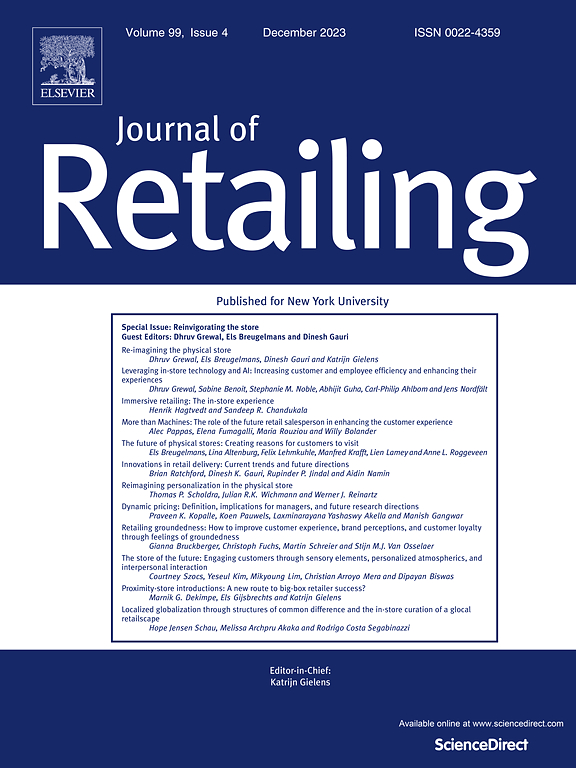清晰的观点,清晰的收益:外部透明度在增加零售环境消费者进入方面的作用
IF 8
1区 管理学
Q1 BUSINESS
引用次数: 0
摘要
零售环境的外部环境对于吸引消费者进入和流量至关重要,但是什么驱动进入?我们研究了每个外部的一个重要设计元素——透明度水平,建议更多的透明度提高提供给消费者的信息量,从而增加消费者进入的可能性。相比之下,透明度较低会降低一个地方的信息量,而透明度较低的地方可以通过其他方式(例如,平面图)向消费者提供更多关于内部的信息,从而增加客流量。通过品牌熟悉度获得的替代信息也可以增加透明度或高或低的地方的进入率。这个提议的过程从传统的环境心理学中以情感为中心的刺激-有机体-反应范式转变为认识到在任何市场互动中提供更多信息的重要性,即使它与建筑环境有关。利用不同的商店类型(如零售、餐馆、健身中心)和模式(图像、虚拟现实),我们的研究为这些效应和潜在机制提供了支持。因此,我们为管理指导展示了透明度的最佳设计配置,同时为零售设计的研究不足的组成部分提供了重要的见解。本文章由计算机程序翻译,如有差异,请以英文原文为准。
Clear views, clear gains: Exterior transparency's role in increasing consumer entry for retail environments
The exterior of retail environments is crucially important for eliciting consumer entrance and traffic, but what drives entry? We examine a prominent design element for every exterior – the level of transparency, proposing that more transparency enhances the informativeness provided to consumers and consequently increases the likelihood of consumer entrance. In contrast, whereas less transparency decreases informativeness about a place, foot traffic for less transparent places can be increased by providing consumers with more information about the interior via other means than transparency (e.g., a floorplan). Alternative information through brand familiarity can also increase entry for more and less transparent places. This proposed process shifts from the traditional emotionally focused paradigm of stimulus-organism-response in environmental psychology and instead recognizes the importance of providing more information within any marketplace interaction, even when it pertains to the built environment. Utilizing varying store types (e.g., retail, restaurants, fitness centers) and modalities (images, virtual reality), our studies provide support for these effects and the underlying mechanism. Consequently, we demonstrate an optimal design configuration of transparency for managerial guidance while providing crucial insights for an under-researched component of retail design.
求助全文
通过发布文献求助,成功后即可免费获取论文全文。
去求助
来源期刊

Journal of Retailing
BUSINESS-
CiteScore
15.90
自引率
6.00%
发文量
54
审稿时长
67 days
期刊介绍:
The focus of The Journal of Retailing is to advance knowledge and its practical application in the field of retailing. This includes various aspects such as retail management, evolution, and current theories. The journal covers both products and services in retail, supply chains and distribution channels that serve retailers, relationships between retailers and supply chain members, and direct marketing as well as emerging electronic markets for households. Articles published in the journal may take an economic or behavioral approach, but all are based on rigorous analysis and a deep understanding of relevant theories and existing literature. Empirical research follows the scientific method, employing modern sampling procedures and statistical analysis.
 求助内容:
求助内容: 应助结果提醒方式:
应助结果提醒方式:


